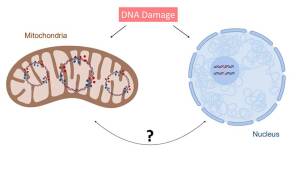Mitochondria and DNA damage
SP26 DNA damage induced adaptive stress responses: the role of mitochondria and mitochondrial DNA damage
DNA damage
Graphic: M. Ermolaeva, FLIProject leader: Maria A. Ermolaeva
Doctoral candidate: Asya Martirosyan
Background and previous work
Persistent DNA damage is known to be a prominent driver of aging, mutations and cell death. On the other hand, our previous work demonstrated that transient genome instability in proliferating cells triggers a systemic response, mediated by ERK MAP kinase, innate immune signals and the ubiquitin proteasome system, which protects the entire organism from infections and proteostasis stress (Ermolaeva et al, Nature 2013). In this project, we will investigate the impact of mitochondria and mitochondrial DNA (mtDNA) damage on the previously uncovered adaptive responses to genotoxic stress.
Specific aims and working programme
Aim 1. Here we will investigate the role of mitochondrial dynamics (fission and fusion) and mitochondrial quality control pathways in DNA damage induced adaptive stress responses. We will inactivate genes implicated in mitochondrial dynamics and quality control (mitochondrial UPR and mitophagy) in C. elegans and test organismal stress responses following exposure to broad-spectrum DNA damaging agents – UVB and ionizing radiation (IR). This work will allow us to determine the importance of mitochondrial homeostasis for organismal responses to genotoxic stress.
Aim 2. Here we will use transgenic nematodes that harbor GFP labelled mitochondria to assess changes of mitochondrial dynamics induced by UVB and IR in vivo in real time. These tests will allow us to understand if genotoxic stress leads to alterations of mitochondrial content or mitochondrial network structure.
In Aim 3, we will perform metabolic measurements (Seahorse analysis, ATP measurements and whole body lipid staining) in wild type and mutant C. elegans treated with UVB and IR to determine the impact of distinct mitochondrial impairments on metabolic responses to genotoxic stress.
Finally, in Aim 4 we will use specific DNA repair mutants in combination with low doses of UVB and IR to induce targeted lesions in nuclear or mitochondrial DNA of C. elegans followed by tests of organismal resilience against protein misfolding and oxidative stress; we will also perform mitochondrial reporter and metabolic tests in these animals. This experimental approach will reveal which DNA containing compartment (nucleus or mitochondria) has the most decisive impact on the adaptive responses to DNA damaging agents.
With this experimental plan our project resides in the interface between RTG 1715 research area 4 “Genotoxic Stress” and research area 1 “Metabolic Stress”, and we anticipate our findings to productively contribute to the developments in both areas.
